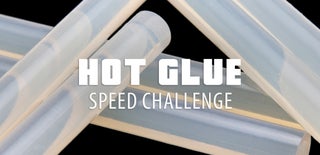Introduction: Custom Foam Inserts
I've recently begun organizing my tools and miscellaneous items better. Harbor Freight bin organizers and my tool cabinets were in long need of some customization. Custom cut outs in foam was the plan for quite some time. I have several large drawers I intent to complete, and wanted custom foam on a tight budget.
Kaizen foam, while easy to work with, is cost prohibitive. There is Foam Factory near-by, but even the will-call prices seem high. I started researching alternatives, including pink insulation boards from Home Depot. I found a suggestion for using Harbor Freight floor mats (and of course a coupon). That along with scraps of foam left over from various packaging material I've been stashing away.
Supplies
- Harbor Freight: Anti-Fatigue Foam Mat Set 4 PC - 25"x25"
- Michael's Craft Store: Foam sheet 12" x 18" x 2mm - various colors for underlayment
- Hot glue gun
- Hot glue sticks
- x-acto knife or carpenters knife
- Straight edge (like a rule)
Step 1: Cut to Size and Shape
For the drawer, bin, or box you'll need to determine the inner dimensions. It's better to cut to long than too short, as you can always trim off the excess.
If the length (or width) is longer than the 25"x25" foam mat, no worries, they already have jigsaw like ends to connect multiple mats to make them as long (or wide) as needed.
Use a pencil (or pen) to mark the cut line on the mat. Use a ruler or straight edge to help guide your blade when cutting. Place something (like a cutting board) underneath so you don't cut through something important. Use the x-acto or carpenter's knife to cut the foam to size.
More complex shapes like the inside of a Harbor Freight storage bin will need some additional work to account for the octagonal shape. If you're doing multiple bins, you can use the first working set as a template.
In some cases, I want to use the bins next to the foam so I just cut a smaller section.
Cut the thinner colored foam to a similar size, and place it aside.
Step 2: Trace the Desired Shapes
You can either trace the tool shapes out on similar sized paper or directly on the foam.
Lay the tools out in the manner you want them organized.
Trace around the tools with a pen or pencil.
Step 3: Cut Out the Shapes
With a cutting board underneath, use the x-acto knife to cut out the shapes you traced. If you traced onto paper, you'll want the paper to be held in place on the foam: you You can test the tool fitting as you go.
Step 4: Attach the Second Layer of Foam
To help with identifying tools that are out of place, and to make it look more professional, I'll be adding a layer of colored foam underneath.
The second layer can either be cut to the same dimensions as the thicker foam, or you can just use smaller pieces large enough for each cutout shape. This method is useful for color coloring; such as SAE=red and metric=blue.
Place the thicker foam face down, line up the thinner colored foam, and apply hot glue to the area around the cutouts (on the thicker foam). Push the colored foam down into place as you go. Because the hot glue dries quickly, try to work on smaller sections at a time. Left to right for instance: lifting the colored foam, applying glue to the thicker foam, and adhering the foam pieces together; section by section.
For some items, like my label maker, I found it useful to attach a second layer of thick foam to raise the height while inside the container. The helps prevent it from shifting or jumping out of the cutout.
Step 5: Finished
The results will be better with the more thought and time you invest.
Some of the drawers and organizer bins I've already completed: Socket drawer (using aluminum socket holder rails and clips to help), pocket hole jig (combination foam for the clamp, the innards of the original case, and bins to hold various pocket screws), label printer (to keep it snug along side bins). I've got a few to go, but finally making some progress.

Participated in the
Hot Glue Speed Challenge













